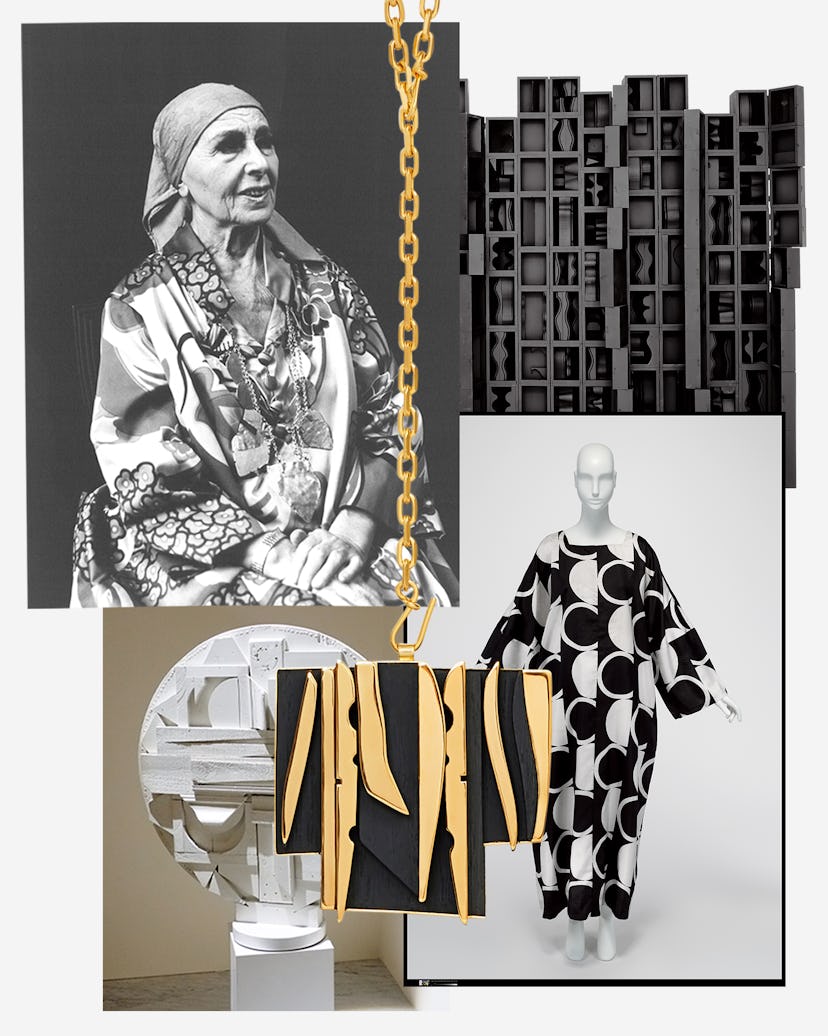Celine Honors the Late Louise Nevelson With a Wearable Work of Art

Louise Nevelson was arguably her own most special creation. A towering figure of 20th-century art, the American sculptor is remembered as much for her theatrical ensembles as for her trailblazing, room-size installations. While Nevelson, who died in 1988, routinely adorned herself in piles of jewelry collected from far-flung travels, less known is the fact that many of the totemic pieces she wore like talismans were designed and made by her in the last 25 years of her life. “These jewels were important mini sculptures,” says Arne Glimcher, the legendary New York art dealer and founder of Pace Gallery, which has represented Nevelson and her estate for 60 years. “I’m surprised it’s taken the fashion world so long to pay attention.”
Portrait of Louise Nevelson by Renate Ponsold, 1979.
Nevelson’s Dawn’s Host, 1959.
The wait is over, now that Celine’s Hedi Slimane has reinterpreted one of Nevelson’s iconic designs. Issued in silver and platinum gold vermeil, the chic amulet—in a limited-edition run of just 50, each set in metal and presented in a special black wooden box—recalls the discarded pieces of wood and the found objects that Nevelson transformed into occult-like sculptures. “Nevelson never cared for anything too overtly mystical, but there is definitely something magical about the piece,” Glimcher says of the design, adding that the original (from about 1985–’86) once belonged to the wife of art scion Christopher Rothko.
Nevelson’s Cascade VII, 1979.
Nevelson’s eccentric style was part of a larger iconoclastic project. As she commented in her book, Dawns + Dusks, “My whole life is one big collage. Every time I put on clothes, I am creating a picture, a living picture, for myself.” Her granddaughter Maria Nevelson remembers how she would wear “a black suit skirt and a corset to the beach, or spray-paint her old shoes gold before she’d come to visit.” “The Nevelson,” as she was christened by her great friend Edward Albee, who immortalized her in his play Occupant, is also remembered for dramatically framing her face with scarves, riding hats, and lashings of heavily applied kohl—to say nothing of her signature mink false eyelashes. “My wife, Milly, started wearing them at one point in the 1960s, and Nevelson really liked them, so Milly gave her three pairs,” Glimcher recalls. “Of course, Nevelson took the three pairs and stuck them all together.” The artist’s adventures in style even earned her a spot on Eleanor Lambert’s International Best Dressed List of 1977. “She loved her vintage store finds and cheap stuff from her travels to places like Iran, India, and Japan,” says Maria, “but she also worked with a lot of high-fashion designers.”
Nevelson collaborated with Rudi Gernreich in the 1960s on a silk evening dress, and gifted it to the Metropolitan Museum of Art in 1979.
Look for Nevelson’s impact to be felt even more in the future. Galerie Gmurzynska has an exhibition of her collages, through January 15, 2022, in its Los Angeles outpost; Gió Marconi will have a show of 15 collages running from April through September 2022; and Nevelson will be featured in “Creating Abstraction,” a major group exhibition being held at Pace’s new London gallery, from February 3 through March 12, 2022. “It’s a big deal,” Glimcher explains, “though she would probably say that it’s about time.”
This article was originally published on